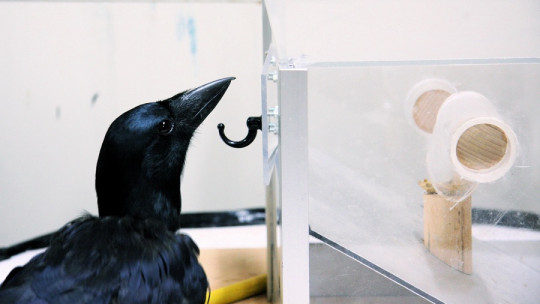
Are there animals that have learned to use tools? This phenomenon has been recorded multiple times, both in nature and in captive environments, with a clear evolutionary purpose for the living being: to facilitate obtaining food, defense, grooming, entertainment or construction of structures.
Sometimes it is difficult for us to recognize that as a species we are not the only ones with such sophisticated cognitive abilities as to manipulate our environment in complex ways. Human society is characterized by a slightly anthropocentric vision since we tend to translate all natural behavior into human terms and purposes to better understand the processes that surround us.
For this reason, the use of tools in animals is a much more controversial topic than one might imagine, since the definition of the word “tool” in itself is already a challenge. If you want to know more about the exciting world of the cognitive abilities of living beings, continue reading.
Animals that have learned to use tools: optimizing the environment
Ethology is the branch of experimental biology and psychology that is responsible for understand animal behaviors, both in laboratory conditions and in their natural environment. The objectives of this discipline are the study of behavior, instinct, relationships with the environment and the patterns that guide innate or acquired behaviors in the world of living beings.
This branch is subject to continuous scrutiny, since the interpretation of animal behaviors can be completely biased by the human who observes them or the experimental conditions that arise. As much as statistical support is required to suspect any type of relationship, their reading will depend considerably on the eyes of whoever interprets them.
For example, if the average laying of various females of an invertebrate species in different areas is taken and those in zone A produce more eggs than those in zone B, there is little else to discuss, right? There appears to be a correlation between geographic area and cohort of offspring produced. After discovering this, we can investigate why: more presence of food, larger females, evolutionary response to more predators, etc.
But, for example, let’s put an experiment in which we have two colonies of bees, one that we have disturbed for the last few hours by shaking its honeycomb and another that we have not. It turns out that the undisturbed colony is more inclined to approach samples with unknown odors, while the one that has been “threatened” is more cautious and only approaches aromatic sources that it already knows (this experiment, although simplified to the extreme, is real).
How do we interpret this data? Can we say that bees are aware of their own state of alertness and that is why they decide not to risk it? Are we dealing with a merely evolutionary primal mechanism or is there some complex cognitive capacity associated with it? Of course, the reading of the results is much more subject to debate than in the previous case.
What we wanted to emphasize with these two examples is that the extent of animal behavior depends largely on who sees it and the parameters measured. Therefore, although it may seem surprising, Not all scientists agree on the existence of animals that have learned to use tools It is not that they deny it completely, but that many cases known to the population would not strictly apply to this definition.
What is a tool?
The first stone we encounter when registering these behaviors is the description of the term tool itself. A fairly widespread definition, proposed in a scientific publication in 1980 and modified since then, is the following:
“The external use of an object available in the environment to more effectively alter the shape, position or condition of an object, another organism or the user, when he or she is the one holding and manipulating the tool. during or before its use and is responsible for its correct and effective orientation.”
As we can see in this rudimentary translation from English, the concept of a tool itself has various meanings to take into account. For certain researchers, the use of objects as if they were tools does not constitute a tool in itself since humans are the only ones capable of modifying an object enough for it to be considered a real tool (and at most, other primates).
For example, when a bird uses a piece of bread to attract a fish and subsequently hunt it (real behavior), we cannot define this piece of food as a tool in itself. The general consensus is that it is a “proto-tool”. Continuing with the example of birds, studies have discovered that birds that use these proto-tools have less developed brains than those that use real tools.
When animals use one tool to obtain another, we are dealing with a “meta-tool.” On the other hand, when they use one tool to later use another, we are dealing with “sequential use of tools.” As we can see, the world of using objects in nature is much more complex than one might initially believe.
To keep the train of thought going and not overcomplicate things, let’s continue with the world of birds. As birds that use “real tools” we have the New Caledonian crows (Corvus moneduloides), as they are capable of making sticks as tools from branches and other plant structures.
It is interesting to know that these tools present a laterality, that is, they are modified according to a specific pattern The branches are effectively modified into a hook shape to be used later to obtain beetle larvae in the recesses of the trees. As we can see, the basal structure is modified to generate an instrument that facilitates a complex activity, so it would, without a doubt, fall into the strictest definition of “tool.”
By presenting this dilemma, examples of tool use in the natural world are called into question. For example, can otters be considered tool users if they use stones to break the shells of the marine invertebrates they consume? Once this information is presented, the minimum is to stop and think for a few seconds: Do you modify the stones before using them?
With these questions we do not want to circumscribe or delimit animal behavior from a skeptical point of view, since we are only trying to express that not everything is as simple as various informative sources try to show. Yes, there are multiple examples of the use of real tools, such as orangutans making improvised whistles from tree leaves to warn others of the presence of predators or chimpanzees making rudimentary “spears” to give hunts prey.
In this specific case the primate must take a branch, tear off the extensions and leave only one and sharpen the end with its teeth. Again, we are faced with the actual manufacture of a tool, since the object itself has been modified for a complex purpose. Of course, when we look at orangutans, gorillas and chimpanzees, things change, because the complex manipulation of natural resources has been observed on multiple occasions and there is little doubt when it comes to recognizing his ability to make tools.
Conclusions
As we can see, the key to understanding animals that have learned to use tools is, first of all, defining what is considered a tool or instrument and what is not.
Things get even more complicated in captive environments, since behaviors that are relatively less common in nature can be recorded for example, due to continuous contact between animals that have already learned to use tools previously or a greater amount of energy and free time that is absent in the natural ecosystem.
Thus, the use of tools in the animal world may (or may not) be more restricted than initially thought. The purpose of the object, its modification and the manipulation of the living being can be conditioning factors for what is considered (or not) according to personal judgment an effective use of the tools.








